How To Set Up Yi Home Camera
Nosotros utilize affiliate links. If you buy something through the links on this page, nosotros may earn a commission at no cost to yous. Larn more than.
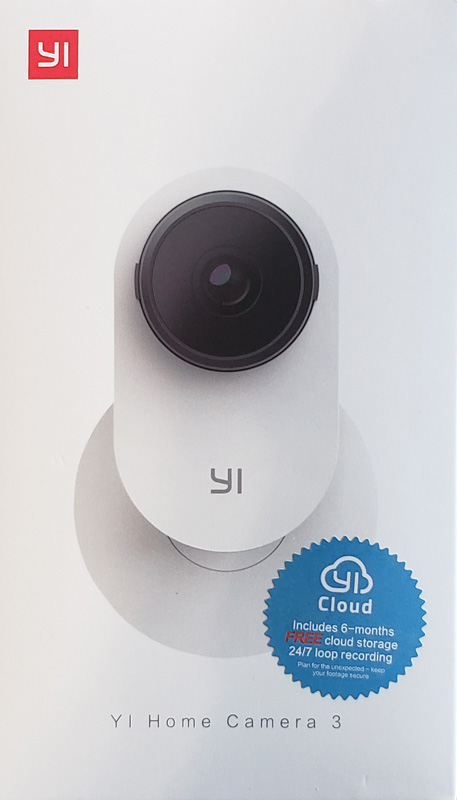
REVIEW – If you believe what yous see on Goggle box, cameras are everywhere. The police force dramas regularly apply surveillance video to get the bad guys. We have also seen all the fun video on Facebook and Youtube from home cameras, catching the family pets, or the family themselves, doing cute, funny, and even dangerous things.
Yi (pronounced "Yee") Technologies has a new entry in their line of connected cameras with the Home Photographic camera three. Should yous go one to capture your ain set up of internet-worthy videos? Allow'southward take a look.
What is it?
The Home Photographic camera 3 (I will just apply "camera" from here on) is a standalone 1080p Wi-Fi camera. Yi also includes six months of cloud storage with subscription options available afterwards that.
What's in the box?
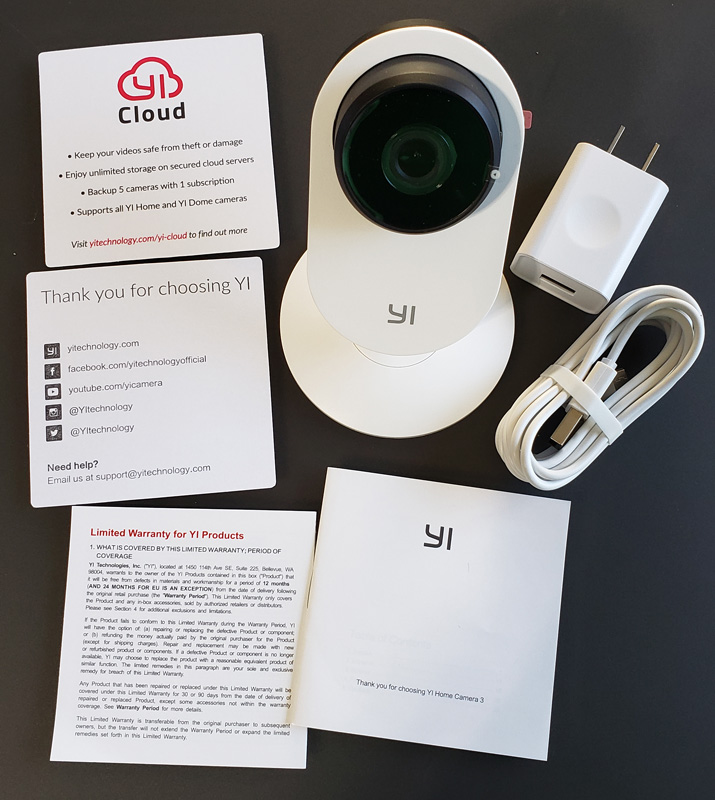
- Home Camera 3
- USB-A to micro USB power cablevision
- USB ability adapter
- Cloud storage info card
- Yi Technology contact card
- Limited warranty
- Instructions
Hardware specs
- Dimensions: 4.3 x five.9 x 4.3 inches
- Weight: 9.6 oz
- Resolution: 1080p (1920×1080)
- Lens view: 107 degrees
- Audio: mic/speaker full duplex
- Wi-FI: 802.11 bgn
- Wireless security: WEP/WPA/WPA2
- Ability: DC 5v/1A Micro USB
- Video compression: h.264
Pattern and features
The camera is nicely styled and can blend into nigh decors. I opted to put the camera in my garage. Here it is on a shelf past the entry door, pointing toward the garage door.
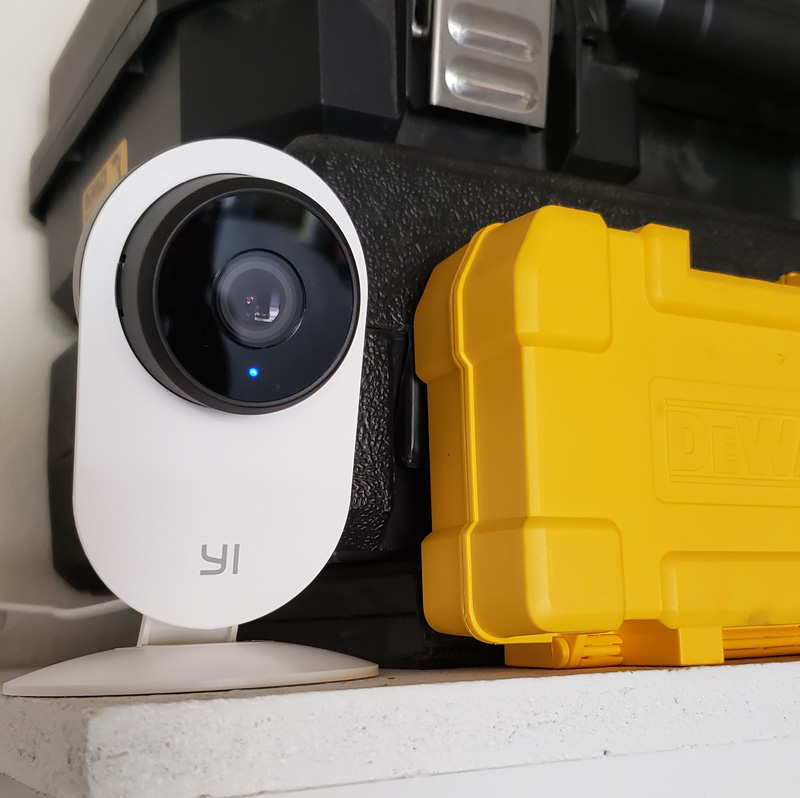
For reference, that yellow case is a set of screwdriver bits. At just over 4 inches tall, the camera fits about anywhere. You can also see the small blue LED below the lens, indicating the photographic camera is online.
The camera has a rotating mount, allowing you to rotate the camera a total 180 degrees, from flat, pointing up, to flat, pointing downwards, relative to the base.
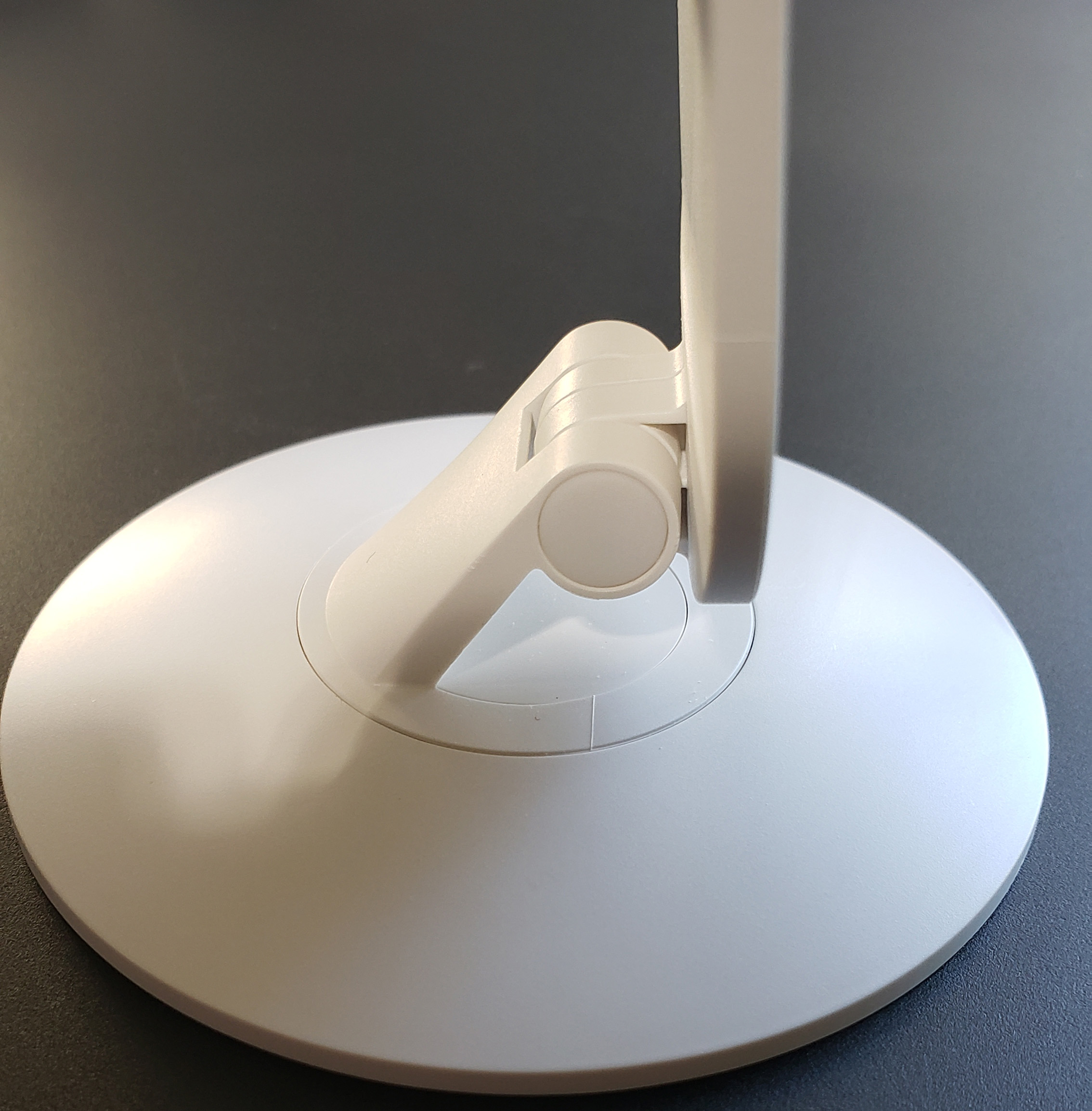
And, that base of operations has a magnet in it, and so you tin mount it to annihilation a magnet can stick to.
On the side, we find a microSD slot.
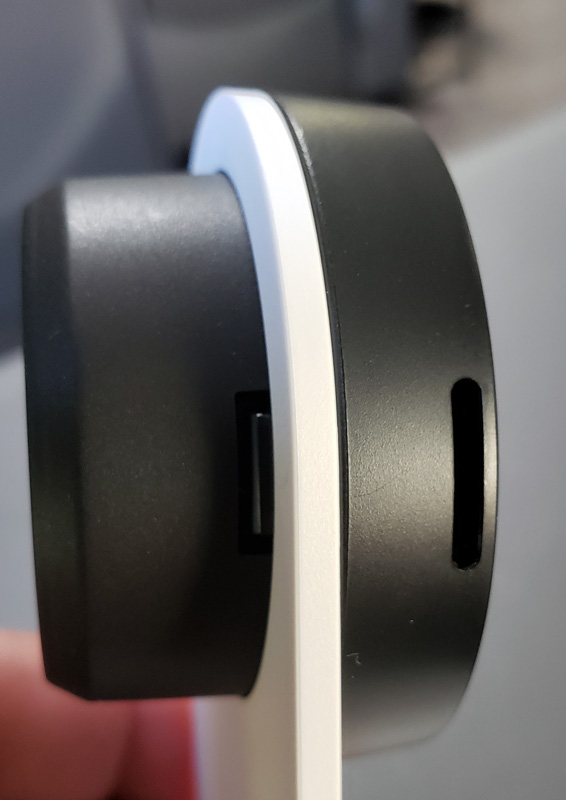
On the bottom of the camera assembly, we detect the USB port for power. This is a powered camera, so you will have to be relatively close to a 110V power plug. It is a picayune snug, getting the ability cord into the port, only with a piddling patience, I got it connected.

Setup
After the unboxing, I installed the Yi Home app on my Galaxy S9+, and ready an account. I inserted my own microSD card into the slot on the camera and plugged in the camera.
The camera surprised me with a serial of verbal updates and commands. They were quite clear and made the setup very smoothen. I didn't get everything transcribed exactly, as the audio came equally a surprise. I will describe the gist of what the phonation prompts conveyed.
As presently equally I plugged in the camera, it welcomed me to Yi Home. It and then reported that it was waiting to connect. In the app, I chose to add a new camera and provided Wi-Fi connection information. The app presented a QR code and the camera told me to put the QR lawmaking in forepart of the lens. Every bit shortly every bit I did, information technology reported that the pairing was successful and that I could begin using the camera. I was impressed with how unproblematic the process was, and how well the camera reported progress. Nice work, Yi.
Performance
Initially, I installed the photographic camera in my living room. The 107-caste view allowed me to see from 1 side of the room all the manner to the other. This is a screenshot from my telephone.
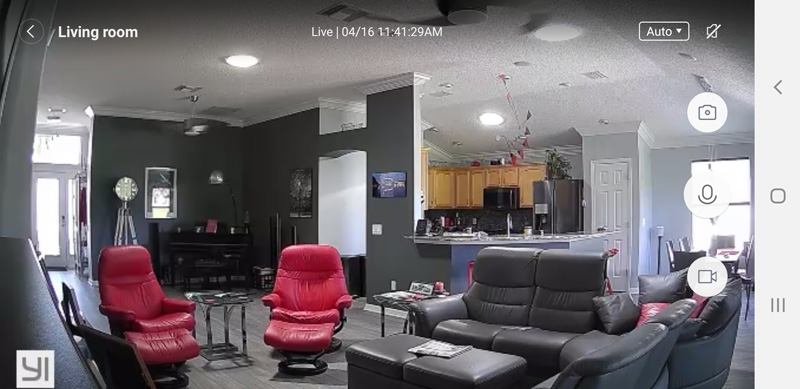
The image quality was pretty impressive with a bright, clear prototype and authentic colors.
After thinking about it, I decided that I really wanted to be able to monitor my garage, so I relocated the photographic camera to the garage. This is a downloaded snapshot from the camera.
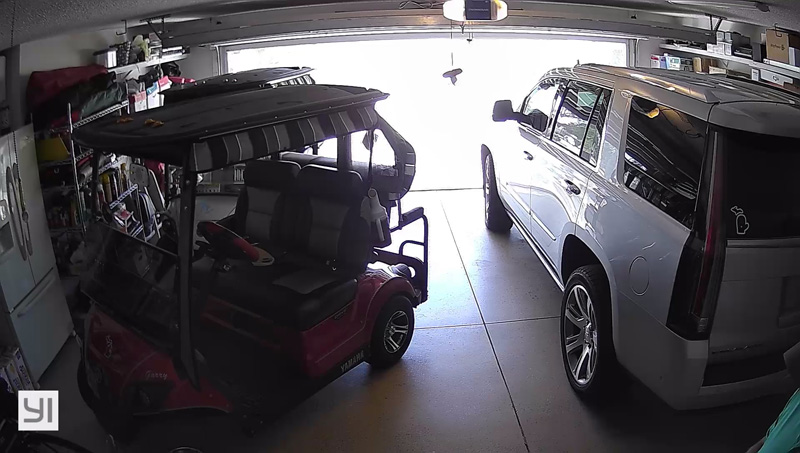
Note that this is really tricky lighting. I have a retractable garage screen, and then much of the fourth dimension, there is strong calorie-free coming in, Still, the camera does a good job showing colors and overall detail. That green in the lower correct is actually my shirt sleeve.
When you view alerts on your phone, they are segregated past day.
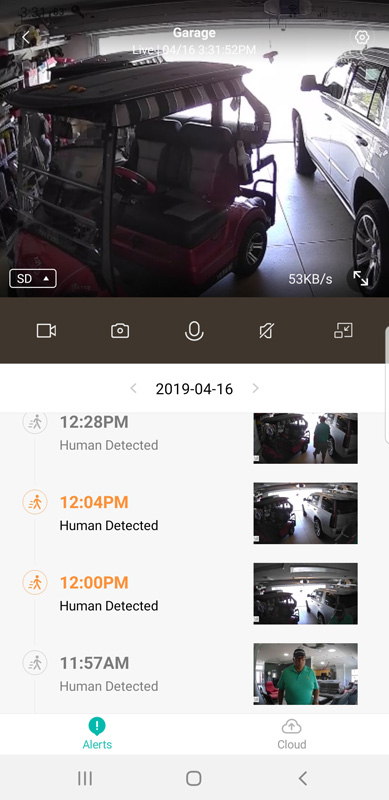
Items that you still need to review are highlighted in orange. Y'all can also alive-monitor the photographic camera. When in that mode, yous can use the microphone on the camera and on your phone to exercise full-duplex ii-way conversations.
In the app, you tin command a broad variety of camera options, similar 180-degree image rotation, turning the camera status calorie-free on/off, whether to employ the IR night vision light, whether yous want to use the camera microphone (mayhap every bit a infant monitor), and if you want the sound to be in push button-to-talk way or full-duplex hands-gratis. You can as well set upwardly camera schedules and whether you want to use cloud storage or but the microSD storage.
Alerts are controlled by some other large variety of option settings. You can cull movement, sound or both to trigger the camera. In addition, they have logic included that detects human being movement versus other movements. In my testing, lowering my garage door triggered as human movement, so that tin certainly be improved. Movement and sound both come with sensitivity adjustments so you can fine-tune the alerts to meet your needs.
Video quality is good, especially given my challenging lighting weather. Here I am heading out to pickleball in the morning.
Downloading video is a niggling finicky. The app is pretty specific about where you tap, and trimming the selected video, while available in the app, is pretty striking or miss.
Another effect is that the videos are not accessible in the app unless deject recording is turned on. Without cloud recording, to view the videos – all mp4 files – you have to popular out the micro SD card, put information technology in an adapter and popular it in your PC. Then, yous accept to detect the right video. The mp4 files are in a folder called "tape" and then subfolders named like <YYYY>Y<MM>M<DD>D<HH>H, so videos from 4/20/2019 at 11am should exist named 2019Y04M20D11H, all the same…they aren't. Everything was exactly iv hours ahead of my local time. I expect that they are labeled for GMT (Greenwich Mean Time), which is four hours ahead of where I am in EDT. My folder for that fourth dimension was labeled 2019Y04M20D15H. The files themselves are labeled similar <mm>M<ss>Southward<tt>.mp4, where mm is replaced with the minute within the hr, ss is replaced with the seconds within the minute when the video begins and tt is replaced with the duration of the clip. It all sounds complicated, but overall information technology makes sense. To find a video recorded on four/21/2019 at 2:33:15 pm that runs 18 seconds, assuming no GMT offset, expect in the 2019H04M21D14H folder for 33M15S18.mp4. Merely remember to add the GMT showtime for your timezone to get to the right folder.
Videos are saved in a rolling fashion, where the oldest recordings are replaced with newer ones as you lot run out of room on the micro SD carte du jour. The number of days you tin can salvage will depend on how often the camera triggers based on our settings and the size of the SD bill of fare. Mine triggers a lot since movement and audio outside the garage screen trigger information technology based on my sensitivity settings. With a 16GB carte, I get nearly three days worth of recordings. I should be able to expand that by lowering the sensitivity a bit to eliminate records of essentially nothing.
If yous opt for cloud recording, six months of seven-solar day rolling cloud recording is included. Afterward that, Yi offers six options:
- 7-solar day rolling, 24-hr continuous for one photographic camera – $19.99/qtr;$66/year
- 7-twenty-four hour period rolling, motility detection only for up to five cameras – $xix.99/qtr;$66/year
- fifteen-solar day rolling, 24-hr continuous for 1 camera – $ix.99/mo;$99/year
- xv-day rolling, motion detection but for up to 5 cameras – $9.99/mo;$99/yr
- 30-twenty-four hour period rolling, 24-60 minutes continuous for one camera – $nineteen.99/mo;$199/twelvemonth
- 30-twenty-four hour period rolling, motion detection just for upward to five cameras – $14.99/mo;$149/twelvemonth
One thing that I don't similar is the app's insatiable demand for power. The starting time day I installed it, my phone battery was really low in the evening – almost 15%. I commonly have 30-40% at that point. When I looked at what was sucking battery, Yi Home was correct at the top of the listing by a long margin. Using the Yi Home app ways that I can't get a full day out of my telephone without recharging. I opted to change the app management settings and allow Android to put Yi Habitation to sleep. That solved the problem, simply, I no longer get alerts from the camera until I open the app. That kind of defeats the purpose. Even today, when I have the app generally sleeping just have opened information technology to write this, Yi Dwelling house has consumed four.3% of my battery over the past hour or then. Google Play Services is the closest at 1.5%. This is kind of a deal breaker for me.
What I like
- Nice design
- Terrific setup process
- Actually good epitome and video quality
- Comprehensive application with lots of customization
- Free deject storage, fifty-fifty though for just 6 months
What needs to be improved
- Yi Home needs to be modified to stop eating my entire bombardment
- Video download interface needs to be improved
- Human detection needs to be improved
- The timestamp on the mp4 files should match local time
- Videos should be viewable in the app directly from the SD card and not crave cloud services
- The instructions should have some explanation about how the SD menu and cloud services work – there is admittedly zip almost it
Final thoughts
Overall, the Yi Hime Camera three is a squeamish trivial photographic camera. It was like shooting fish in a barrel to fix and produces great images and video. But until the app can exist modified to stop wiping out my phone battery, I will have to take the app sleep about of the fourth dimension, eliminating much of the benefit of a monitored camera.
Price: $49.99
Where to buy: Amazon
Source: The sample of this product was provided by Yi Technology.
Source: https://the-gadgeteer.com/2019/04/27/yi-home-camera-3-review/
Posted by: mcdonaldyone1997.blogspot.com


0 Response to "How To Set Up Yi Home Camera"
Post a Comment